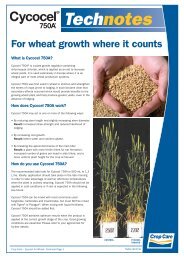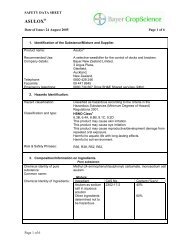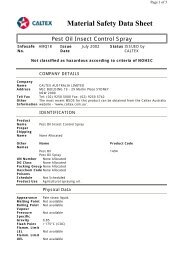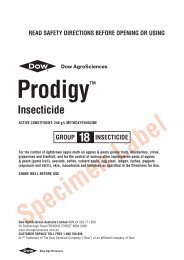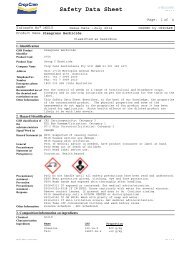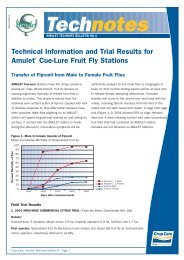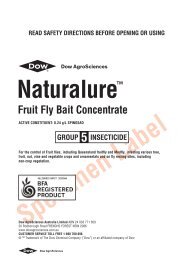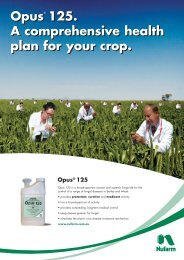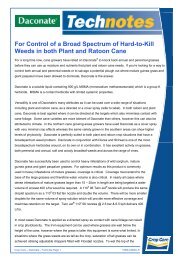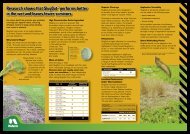Fastac Duo Technical Manual - Pest Genie
Fastac Duo Technical Manual - Pest Genie
Fastac Duo Technical Manual - Pest Genie
Create successful ePaper yourself
Turn your PDF publications into a flip-book with our unique Google optimized e-Paper software.
BLACKHEADED<br />
PASTURE COCKCHAFER<br />
(Aphodius tasmaniae)<br />
- Pastures<br />
The adult is a dark brown beetle approximately<br />
1cm long with a broad shovel-like head. It is<br />
sometimes mistaken for blackbeetle which attacks<br />
suburban household lawns.<br />
The larvae are a grey to white, six-legged grub<br />
with a black to dark brown head capsule. Fully<br />
grown they are up to 2cm long.<br />
The adult beetles emerge from the soil in late<br />
December to early March following summer rainfall<br />
at which time they mate and commence egg laying.<br />
The female can produce between 30 to 80 eggs.<br />
Depending on soil moisture, beetles may lay eggs<br />
in greater densities on rising positions of paddocks<br />
which generally have the barest soil surface.<br />
Blackheaded<br />
pasture cockchafer<br />
larvae<br />
consequent pasture damage occurs from May to<br />
J u l y, which coincides with the heaviest demand<br />
from the grazing animals for pasture feed.<br />
An average infestation of 300-400 larvae per<br />
square metre can cause a 50%-70% reduction in<br />
winter pasture production and a 40%-50% loss of<br />
desirable pasture species production in spring.<br />
L a rval feeding preference is for legumes (clovers)<br />
then grasses and finally broadleafed weeds such as<br />
c a p e w e e d .<br />
Cockchafer damage is multiplied when heavily<br />
infested pastures are dug up by birds such as crows<br />
and ibis in an attempt to feed.<br />
Redheaded Pasture Cockchafer<br />
Although less widespread than Blackheaded<br />
c o c k c h a f e r, they cause significant damage, to<br />
annual pastures as the larvae are totally soil<br />
dwelling and feed on the roots of pasture plants.<br />
The adult is a plump brown to black beetle<br />
approximately 13mm long and 8mm wide. The<br />
l a rvae are six legged grubs which grow to 25mm<br />
long and have a red-brown head capsule.<br />
After 4 to 5 weeks the larvae hatch but do not<br />
move to the surface to feed on decaying organic<br />
matter until rain has fallen. If rainfall does not<br />
occur within 30 days of egg hatch, up to 50% of<br />
young larvae may die. Therefore wet summers<br />
are more likely to produce severe outbreaks<br />
than dry summers.<br />
The first instar larvae only feed on organic matter.<br />
The second and third instar (late April to July) stages<br />
feed on green surface plant material and usually<br />
come to the soil surface after heavy rain or heavy<br />
d e w. After larvae have come to the surface to feed,<br />
soil casts can be seen at the opening of their tunnels<br />
and fresh foliage may be found in their tunnels.<br />
L a rvae can store sufficient food in their tunnels for<br />
6 to 8 days. If rain has not fallen for 9 to 10 days,<br />
the larvae will return to the soil surface to feed.<br />
L a rvae store fat and reduce feeding from August on<br />
and then seal themselves in the bottom of their<br />
tunnels to pupate in November and December.<br />
The period of greatest larval activity and<br />
1 3<br />
C o n t r o l :As the larvae are soil dwelling insects,<br />
e fficient chemical control is not available.<br />
If substantial numbers of larvae (in excess of 350 to<br />
400 per square metre) are monitored at the time of<br />
opening rains, consideration should be given to the<br />
cultivation of the worst affected areas. The sowing<br />
of a cereal crop to compensate for the expected loss<br />
in pasture stock feed is advised.<br />
The Solution<br />
Apply FA S TAC <strong>Duo</strong> at the label rate within 4<br />
weeks of opening rains when larvae are less than<br />
1 cm in length.<br />
It is preferable to apply by boomspray in 60 to<br />
80 litres of water per hectare as a fine spray<br />
producing a droplet size of 100-200 microns<br />
VMD. Spraying is most effective when larvae are<br />
detected and treated early.<br />
Suspect paddocks should be dug after the first<br />
substantial rain in April/May and inspected to<br />
ensure grubs are present in sufficient numbers to<br />
warrant treatment.<br />
FA S TAC DUO



